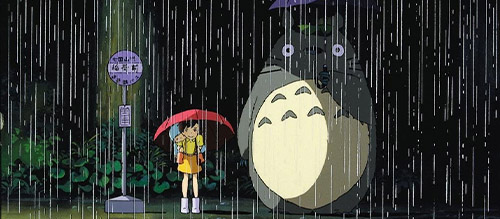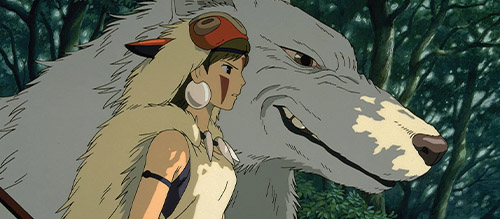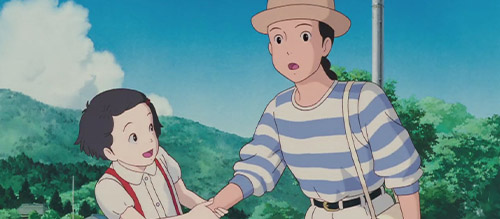Where to Start with Studio Ghibli
If you want to get into Japanese feature animation, the films made by Studio Ghibli are a great place to start. What’s even better for any potential inductees is that all but one of them are now available to stream on Netflix. But, with 21 films made over 28 years, where do you begin? We’re here to offer an answer to that question, with the hope that you too will fall in love and be swept away by the magic of these modern animated fairy tales.
Ghibli in brief, then – what do you really need to know?
Well, first off it’s Ghibli with a “soft g” as in “ginger”. The studio was founded in 1985 by directors Hayao Miyazaki and Isao Takahata with producer Toshio Suzuki. That cute rotund animal character on the studio logo is Totoro. While the studio has worked with a great many animation directors, the most features and most acclaimed films have been made by Miyazaki (9) and Takahata (5). As well as award-winning feature films and shorts, animators from the studio have worked on video games such as the “Ni no Kuni” series. The studio holds such a cultural prominence that a Ghibli Museum was even opened in Tokyo in 2001.
For a complete history of Studio Ghibli, please see this article from The Film Magazine: A Brief History of Studio Ghibli. The definitive documentary The Kingdom of Dreams and Madness is also an excellent resource.
Before the Disney-sponsored high-profile re-dubbing of the late 1990s, beginning with Kiki’s Delivery Service, Studio Ghibli would have just been another anime studio to animation fans in the West. But under Miyazaki’s leadership they have become giants in the field of international animation, and have maintained their independence and unique voice throughout their history, always maintaining (especially with the Disney re-issues) that there would be no cuts to their films. Disney remain involved with re-dubbing vocal performances for English-speaking audiences to this day, enlisting Hollywood talent from Saoirse Ronan and Hailee Steinfeld to Christian Bale and Liam Neeson to do so.
Spirited Away may have been the film that introduced Ghibli to many of its die hard fans today (Oscar nominations always help), but you might be better watching a few of the earlier works from the studio first to better understand what makes this animation house tick. The great thing about Studio Ghibli is you could really start anywhere – there is something to suit all tastes in their back catalogue. Take this Ghibli primer and the following recommendations as one suggested route into their world and prepare to fall head-over-heels for these wonderful films.
1. My Neighbour Totoro (1988)
For a prime example of Ghibli’s gentle fantasy escapism, you can’t go wrong with My Neighbour Totoro. Like the majority of Hayao Miyazaki’s films (especially Spirited Away), Studio Ghibli’s third film is a heavily Lewis Carroll-inflected piece of fantasy escapism for children.
Like “Alice in Wonderland”, we follow girls escaping the troubles of everyday life through fantasy. Two sisters move to the country with their dad while their mum is in hospital. The younger sister finds a passage to another world and meets the titular happy, sleepy forest spirit. She eventually brings her older sister along and both go on fantastical nighttime adventures with their new friends, laughing, playing and riding the “Catbus” high into the sky.
This is the perfect Studio Ghibli film for younger children.
2. Princess Mononoke (1997)
For an introduction to Miyazaki’s political voice and ambition, Princess Mononoke is perfect.
It’s still fantastical and hugely imaginative, but it’s also dark and epic, and all about humanity maintaining harmony with the world’s ecosystems. As well as being a passionate environmentalist, Miyazaki is a pacifist, as seen in Laputa, Porco Rosso and Howl’s Moving Castle.
Here, a boy on a quest gets swept up in a battle between the warlike leader of an industrial township and a warrior princess and the forest guardians she protects. Younger viewers will still be entranced by the fantastical visuals and propulsive action, but it does get intense and pretty dark, and there is blood and dismemberment in the fight scenes – parents be aware.
3. Only Yesterday (1991)
For an example of the more grounded domestic stories Ghibli produces, I’d suggest going for Isao Takahata’s Only Yesterday.
Takahata generally tends to dial back on fantasy except for the odd flourish (see My Neighbours the Yamadas) and focus on ordinary family units going through their real lives. His most acclaimed work, Grave of the Fireflies, is phenomenal but absolutely harrowing, which is why it’s suggested you start with something a bit lighter from his back catalogue.
This one is more suitable for older viewers, Studio Ghibli’s attempt to tell an adult drama through the medium of animation. Many parents will relate to this film about a woman looking back and reflecting on her life, but it may leave little ‘uns somewhat restless.
Recommended for you: 10 Best Studio Ghibli Films





